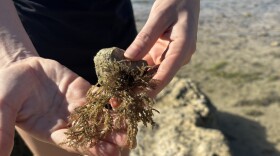Hawai‘i researchers have successfully grown a tropical sea urchin from a cryopreserved embryo — a promising first for ocean science.
University of Hawaiʻi graduate student Charley Westbrook spearheaded the project. He created a bank of cryopreserved urchin embryos, then thawed the specimens months later.
"Honestly, I didn't really expect it to succeed on the first try," he said. "The first time I saw them settle on the glass of my beaker, I was ecstatic. I was like, I can't believe this worked."
One urchin named Spike is the first embryo to reach the juvenile stage. Spike is a collector urchin, an important species for the health of Hawaiʻi’s reefs, says Westbrook.
He first worked with collector urchins as part of a biocontrol project with the State Division of Aquatic Resources.
"We would go out on those 'Super Sucker' barges that they use to help remove invasive algae from the various reefs in the bay. And after manually removing a lot of that algae, they would go back out and disperse juvenile urchins all over the reef to kind of help clean up whatever was left," Westbrook told HPR.
Collector urchins help keep algae growth in check and give coral a chance to recolonize the reefs, he said.
Westbrook says the next step is to see if Spike and other specimens can survive into adulthood and reproduce in the wild.
"I still have a few other experiments I would like to look at with this particular species. To me, this species is extremely important to the ecosystems here in Hawai'i, and so it's one that I've been focused on for a few years now," he said. "But you never know what doors might open in the future."
Westbrook and Mary Hagedorn work out of the Hawaiʻi Institute of Marine Biology on Coconut Island in Kāneʻohe. The groundbreaking research was announced by the Smithsonian's National Zoo and Conservation Biology Institute.
Hagedorn says this is a major step in protecting diversity among Hawaiʻi's coral reefs in the face of climate change.
"There have been times when these urchins have gotten diseases and their populations have been impacted. So if we can actually go around the state and collect different populations and cryopreserve them, that will make the whole bioremediation process very secure. But in addition, you know, this is a model for other tropical species," Hagedorn said.
This interview aired on The Conversation on Aug. 4, 2022. The Conversation airs weekdays at 11 a.m. on HPR-1.





